Structure and dynamics of Pilgerodendron uviferum forests affected by fires in the coastal range of Chiloe Island
Main Article Content
Abstract
Currently, Pilgerodendron uviferum forests cover over 172,000 hectares of Chiloé Province. The traditional utilization of these forests caused the destruction and burnt of extensive areas of cypress. Therefore this species was classified by IUCN as vulnerable and included in Appendix I of CITES. This study aimed to analyze and characterize the dynamics of P. uviferum forests in the coastal range of Chiloé, specifically in four sites (one pristine and three disturbed) located near Lake Tepuhueico in the center-south of Chiloé Island. A floristic composition evaluation and quantitative, diametric and age structure analyses for each sector were conducted. Furthermore, the original stand structure of the burnt Pilgerodendron forests, existing before the fire, was reconstructed. The fire that occurred in the study area produced big changes in the habitat, exceeding the persistence threshold of P. uviferum. The disturbed zone was considerably damaged on its structure, showing substantial reductions of basal area (over 90%) and density (over 87%) for the species. This event allowed the establishment and dominance of young second-growth mixed stands of Nothofagus nitida, Drimys winteri and Tepualia stipularis which, in undisturbed sites, belong to a different succesional sequence. However, there are small pristine stands of P. uviferum that must be preserved because of their structural complexity and their importance as seed suppliers for disturbed neighboring areas.

